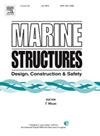均匀弯曲条件下近端管件无粘结柔性管的抗拉护甲性能
IF 4
2区 工程技术
Q1 ENGINEERING, CIVIL
引用次数: 0
摘要
本文建立了一个理论模型,研究了在摩擦条件下,在轴向拉伸和均匀弯曲条件下,端部配合对无粘结柔性管拉伸装甲滑移和应力的影响。该问题的特点是一个单一的装甲线螺旋缠绕在圆柱形的支撑表面,受到张力和弯曲。从初始螺旋角的偏差被用来描述管道拉伸和弯曲时装甲的路径。这个角度变化的积分给出了金属丝的横向位移,这是由由轴向应变、局部弯曲和扭转引起的应变能和摩擦耗散的能量组成的能量函数的最小化决定的。这就导致了端点固定的变分问题。将得到的微分方程转化为边值问题,用数值方法求解。利用有限元仿真对所建立的模型进行了验证。横向滑移和局部弯曲应力的模型预测结果与有限元结果的比较表明,模型预测结果具有良好的相关性。结果还表明,当钢丝从内点和外点出发时,轴向滑移和应力的理论解与数值结果吻合较好。利用验证后的模型,研究了施加张力、整体曲率、摩擦系数和初始极角对末端拟合横向弯曲应力的影响。结果表明:端部约束会使装甲导线在端部装配附近产生明显的应力增大;响应对张力是线性的,但对曲率是非线性的。与无摩擦情况相比,摩擦可以显著增加末端拟合的应力。关键位置在管道受拉的一侧。研究了环箍初始位置对轴向应力的影响。当从内肌点或外肌点出发时,固定条件对近端肌腱的轴向应力没有影响。本文章由计算机程序翻译,如有差异,请以英文原文为准。
The tensile armor behavior of unbonded flexible pipes close to end fitting under uniform bending
A theoretical model is presented to investigate the impact of end fitting on slip and stress of tensile armors in unbonded flexible pipes under axial tension and uniform bending in the presence of friction. The problem is characterized by a single armor wire helically wound around a cylindrical supporting surface which is subjected to tension and bending. The deviation from the initial helical angle is used to describe the path of the armor as the pipe is stretched and bent. The integral of this angle change gives the lateral displacement of the wire, which is determined by minimizing the energy functional that consists of the strain energy due to axial strain, local bending and torsion, and the energy dissipated by friction. This leads to a variational problem with fixed endpoints. The obtained differential equation is transformed into a boundary value problem, which is solved numerically. The developed model is verified using a finite element (FE) simulation. Comparisons between the model predictions and the FE results regarding the transverse slip and local bending stress demonstrate good correlations. The results also show that the theoretical solutions of axial slip and stress are in good agreements with the numerical outputs when the wire starts from the intrados or extrados points. The verified model is then applied to study the effects of imposed tension, global curvature, friction coefficient and initial polar angle on the transverse bending stress at the end fitting. The results show that the end restraint could cause a significant stress increase in the armor wire at the end fitting vicinity. The response is linear with respect to tension but nonlinear to curvature. Friction could significantly increase the stress at the end fitting compared to the frictionless case. The critical location is on the tensile side of the pipe. The effect of initial hoop position on the axial stress is also studied. The fixed condition has no influence on the axial stress in the tendon close to the end when it starts from the intrados or extrados points.
求助全文
通过发布文献求助,成功后即可免费获取论文全文。
去求助
来源期刊

Marine Structures
工程技术-工程:海洋
CiteScore
8.70
自引率
7.70%
发文量
157
审稿时长
6.4 months
期刊介绍:
This journal aims to provide a medium for presentation and discussion of the latest developments in research, design, fabrication and in-service experience relating to marine structures, i.e., all structures of steel, concrete, light alloy or composite construction having an interface with the sea, including ships, fixed and mobile offshore platforms, submarine and submersibles, pipelines, subsea systems for shallow and deep ocean operations and coastal structures such as piers.
 求助内容:
求助内容: 应助结果提醒方式:
应助结果提醒方式:


